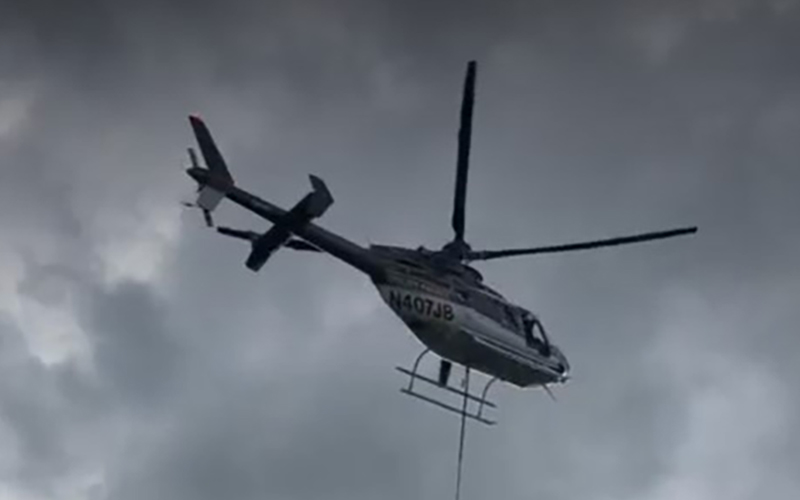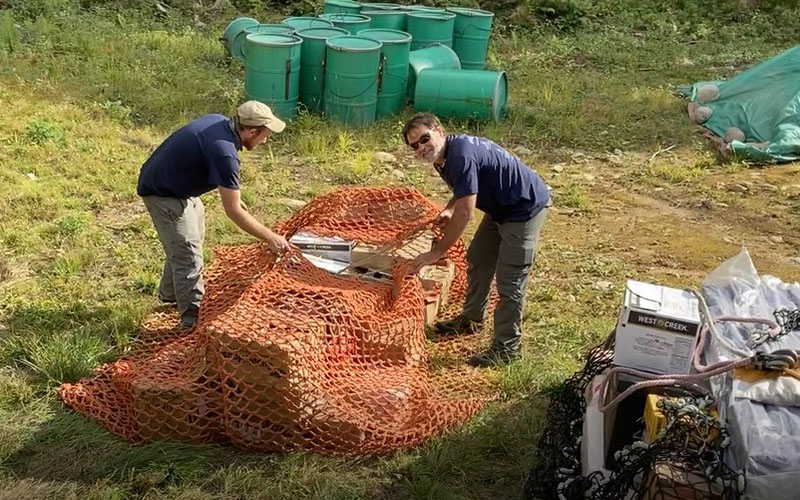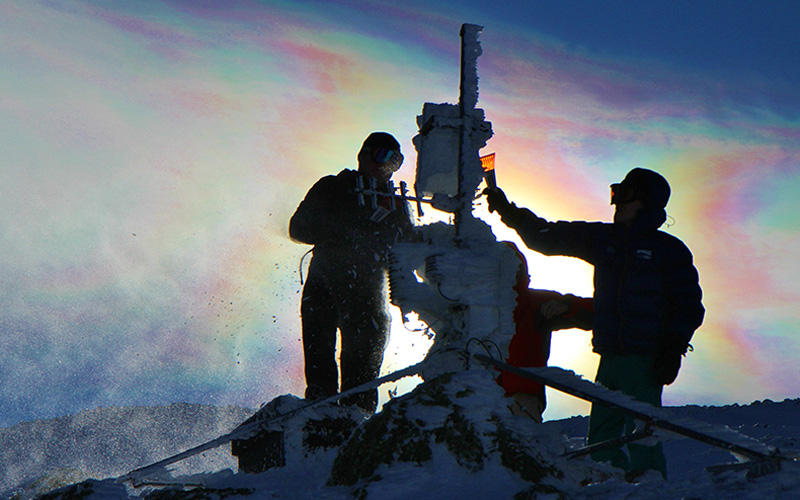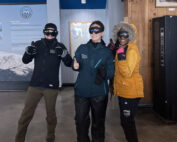Partnerships Key to Continuous Mesonet Operation
By Peter Gagne, Technology & Operations Manager | November 15, 2021

An AMC helicopter airlifts 150-pound batteries plus other heavy items to Mizpah Spring and Lakes of the Clouds huts on Sept. 13.
Ringo Starr was mostly the silent, steady figure in the Greatest Band of all Time, but one line from a Beatles’ song that featured his vocals is particularly pertinent to our topic: “Oh, I get by with a little help from my friends.”
During my time at the Observatory, we have partnered with many businesses, organizations, and universities to support our Mount Washington Regional Mesonet (MWRM). These include Campbell Scientific, Vaisala, Taylor Engineering, Boston Dynamics, Plymouth State University, UNH, MIT, UMass Lowell, and even our local Kennett High School machine shop class. Most of the local ski areas have been instrumental in situating mesonet sites at elevation. Sites are also provided by the Cog Railway, Mount Washington Auto Road, and private landowners such as the Progins in Jackson on top of old Tyrol Ski Area.
I’d like to focus on one partner in particular, the Appalachian Mountain Club (AMC).
MWRM, our multi-site connected series of weather stations, would not be possible without AMC’s permission and cooperation. Some of the earliest mesonet stations were installed at their Mizpah Spring Hut, Lakes of the Clouds Hut, the Hermit Lake Shelters, and the Highland Center. These sites were already operating prior to my start at the Observatory in August 2010, although in some cases they were not fully completed. I was the “new guy,” replacing my predecessor Brian Forcier, and I was crazy jealous to hear of helicopter trips to transport tower sections and heavy equipment, arranged courtesy of AMC staff. Perhaps someday, I’d get the chance to “fly like an eagle.”
Much of the MWRM was funded by grants obtained in partnership with AMC. The Obs was operating under the three-year Alpine Project when I started. It was a multi-pronged approach to expand our mesonet, developing a web-based system for data display and educational modules, such as distance learning via teleconference, outreach through use of new displays, Edutrips, presentations, guest speakers, and articles in membership publications. Needless to say, there were many people involved from many departments across both organizations.
In all symbiotic relationships, there is give and take. In addition to providing historical weather data for AMC’s internal research, our interactive system provides access to live information beyond temperature, humidity, and wind at their hut locations. We also monitor their solar arrays and battery voltage in real time. This way, they know in an instant if there are any problems. In some cases, we have installed and operated specific weather instruments at AMC’s request. Examples include ground temperature sensors at ARVP 5,300 and an ozone counter at the Cog Base, among many others.
In fall 2021, our mesonet team was tasked with providing our own solar power at Mizpah and Lakes huts. We had been operating on AMC’s solar arrays at both of these sites since they were established, but they have been slowly switching from lead-acid to lithium-ion batteries, which provide an infinitely more stable power output, but cannot be charged below 32 degrees. That obviously is a problem in the White Mountains, so we had to devise a solution.
Working together with Tom Siedel, Seth Quarrier, and David Evankow, we came up with a plan that does not require us to install new exterior solar panels. Adding anything on the outside of the huts requires Nation-al Forest approval, and that can take years in some cases. So they are allowing us to tap into their existing photovoltaic array, as long as we have our own charge controller and batteries separate from their system.

Technology & Operations Manager Pete Gagne, right, helps an AMC staffer prepare for the airlift.
We purchased a Midnite Solar “The Kid” charge controller and a Sunwize 240 amp/hour AGM battery for the job. Lots of wires, connectors, conduit, hangers, and other hardware make quite a load, and we’re grateful to AMC for helping with logistics to get every-thing to the remote sites.
Some may have noticed that data from Lakes of the Clouds hasn’t been displaying for quite some time. The old radio failed, and the last spare we had was no good, so we decided it was time to replace all of the radios on the west-ern side of the Observatory with newer, faster ones. We hope to complete this work before winter.
With AMC’s support, we will keep the lights on (figure of speech) and the data flowing from these sites.

The Mount Washington Regional Mesonet is comprised of more than a dozen remote weather stations, each needing continuous monitoring and maintenance to capture weather conditions across the varied White Mountains terrain.
Team Flags Return for Seek the Peak’s 25th Anniversary
Team Flags Return for Seek the Peak's 25th Anniversary By MWOBS Staff Mount Washington Observatory is looking forward to continuing a much-loved tradition for Seek the Peak’s 25th Anniversary: Team flags. In inviting teams
Meet Summer Interns Zakiya, Max and Maddie
Meet Summer Interns Zakiya, Max and Maddie By MWOBS Staff We are excited to welcome six teammates to the summit of Mount Washington this summer! During their internship, these students and graduates will play
Saying Goodbye to the Summit
Saying Goodbye to the Summit By Alexis George After an extraordinary last three years working as a Weather Observer and Meteorologist, I am excited to pursue a different career. As sad I as am




